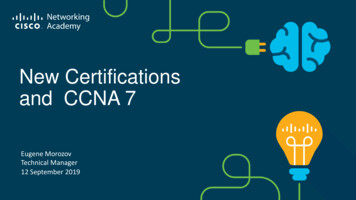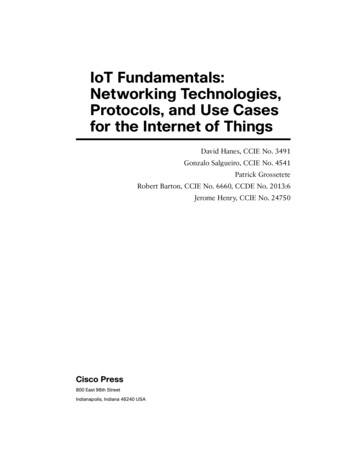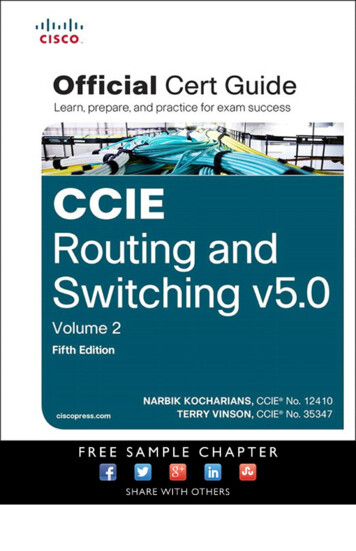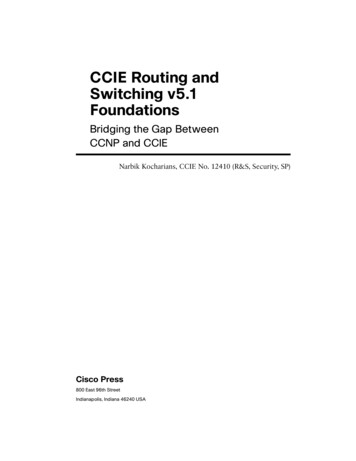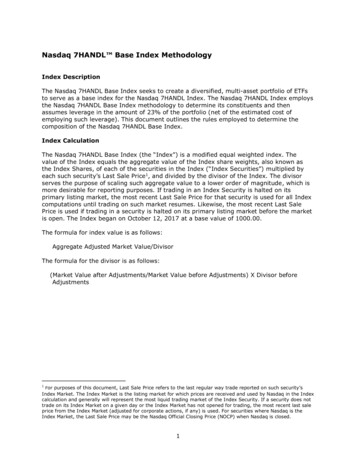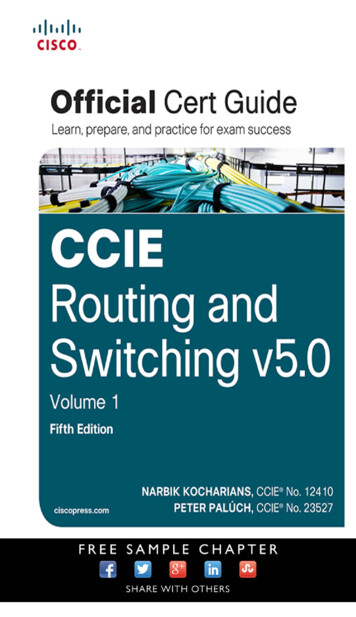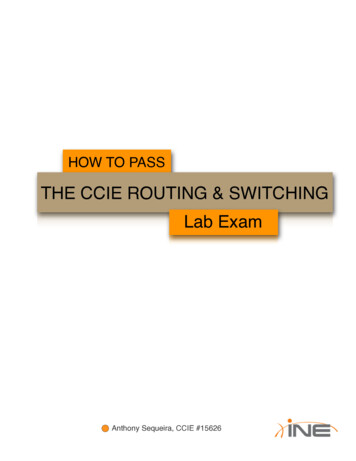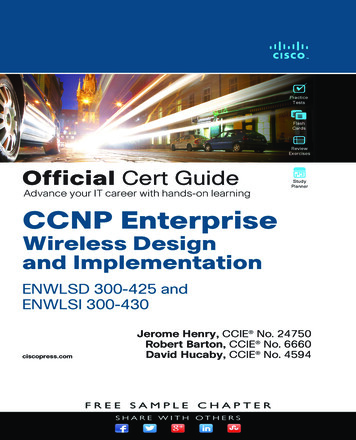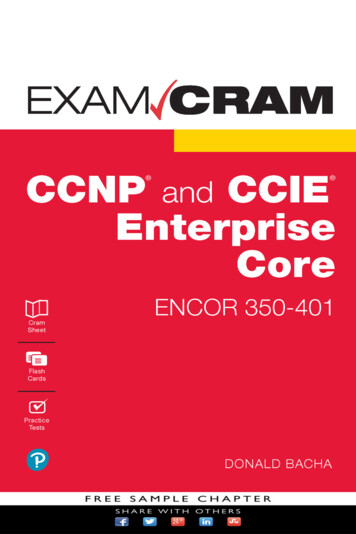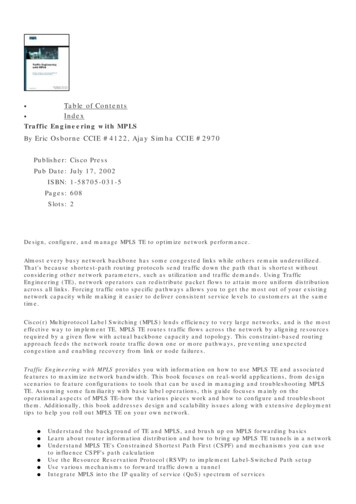
Transcription
Table of ContentsIndex Traffic Engineering with MPLSBy Eric Osborne CCIE #4122, Ajay Simha CCIE #2970Publisher: Cisco PressPub Date: July 17, 2002ISBN: 1-58705-031-5Pages: 608Slots: 2Design, configure, and manage MPLS TE to optimize network performance.Almost every busy network backbone has some congested links while others remain underutilized.That's because shortest-path routing protocols send traffic down the path that is shortest withoutconsidering other network parameters, such as utilization and traffic demands. Using TrafficEngineering (TE), network operators can redistribute packet flows to attain more uniform distributionacross all links. Forcing traffic onto specific pathways allows you to get the most out of your existingnetwork capacity while making it easier to deliver consistent service levels to customers at the sametime.Cisco(r) Multiprotocol Label Switching (MPLS) lends efficiency to very large networks, and is the mosteffective way to implement TE. MPLS TE routes traffic flows across the network by aligning resourcesrequired by a given flow with actual backbone capacity and topology. This constraint-based routingapproach feeds the network route traffic down one or more pathways, preventing unexpectedcongestion and enabling recovery from link or node failures.Traffic Engineering with MPLS provides you with information on how to use MPLS TE and associatedfeatures to maximize network bandwidth. This book focuses on real-world applications, from designscenarios to feature configurations to tools that can be used in managing and troubleshooting MPLSTE. Assuming some familiarity with basic label operations, this guide focuses mainly on theoperational aspects of MPLS TE-how the various pieces work and how to configure and troubleshootthem. Additionally, this book addresses design and scalability issues along with extensive deploymenttips to help you roll out MPLS TE on your own network. Understand the background of TE and MPLS, and brush up on MPLS forwarding basicsLearn about router information distribution and how to bring up MPLS TE tunnels in a networkUnderstand MPLS TE's Constrained Shortest Path First (CSPF) and mechanisms you can useto influence CSPF's path calculationUse the Resource Reservation Protocol (RSVP) to implement Label-Switched Path setupUse various mechanisms to forward traffic down a tunnelIntegrate MPLS into the IP quality of service (QoS) spectrum of services
Utilize Fast Reroute (FRR) to mitigate packet loss associated with link and node failuresUnderstand Simple Network Management Protocol (SNMP)-based measurement andaccounting services that are available for MPLSEvaluate design scenarios for scalable MPLS TE deploymentsManage MPLS TE networks by examining common configuration mistakes and utilizing toolsfor troubleshooting MPLS TE problems
Table of ContentsIndexTraffic Engineering with MPLSBy Eric Osborne CCIE #4122, Ajay Simha CCIE #2970Publisher: Cisco PressPub Date: July 17, 2002ISBN: 1-58705-031-5Pages: 608Slots: 2CopyrightAbout the AuthorsAbout the Technical ReviewersAcknowledgmentsCommand Syntax ConventionsForewordIntroductionWho Should Read This Book?How This Book Is OrganizedChapter 1. Understanding Traffic Engineering with MPLSBasic Networking ConceptsWhat Is Traffic Engineering?Traffic Engineering Before MPLSEnter MPLSUsing MPLS TE in Real LifeSummaryChapter 2. MPLS Forwarding BasicsMPLS TerminologyForwarding FundamentalsLabel Distribution ProtocolLabel Distribution Protocol ConfigurationSummaryChapter 3. Information DistributionMPLS Traffic Engineering ConfigurationWhat Information Is DistributedWhen Information Is DistributedHow Information Is DistributedSummaryChapter 4. Path Calculation and Setup
How SPF WorksHow CSPF WorksTunnel ReoptimizationResource Reservation Protocol (RSVP)Interarea TunnelsLink ManagerSummaryChapter 5. Forwarding Traffic Down TunnelsForwarding Traffic Down Tunnels Using Static RoutesForwarding Traffic Down Tunnels with Policy-Based RoutingForwarding Traffic Down Tunnels with AutorouteLoad SharingForwarding AdjacencyAutomatic Bandwidth AdjustmentSummaryChapter 6. Quality of Service with MPLS TEThe DiffServ ArchitectureA Quick MQC ReviewDiffServ and IP PacketsDiffServ and MPLS PacketsLabel Stack TreatmentTunnel ModesDiffServ-Aware Traffic Engineering (DS-TE)Forwarding DS-TE Traffic Down a TunnelSummaryChapter 7. Protection and RestorationThe Need for Fast RerouteWhat Is Protection?Types of ProtectionLink ProtectionNode ProtectionAdvanced Protection IssuesSummaryChapter 8. MPLS TE ManagementMPLS LSR MIBMPLS TE MIBSummaryChapter 9. Network Design with MPLS TESample Network for Case StudiesDifferent Types of TE DesignTactical TE DesignOnline Strategic TE DesignOffline Strategic TE DesignProtection ScalabilityForwarding Adjacency ScalabilitySummaryChapter 10. MPLS TE Deployment Tips
Bandwidth and Delay MeasurementsFine-Tuning MPLS TE ParametersMigrating IS-IS from Narrow to Wide MetricsTE and MulticastTunnel Identification SchemesCombining MPLS TE with MPLS VPNsDeployment PossibilitiesSummaryChapter 11. Troubleshooting MPLS TECommon Configuration MistakesTools for Troubleshooting MPLS TE ProblemsFinding the Root Cause of the ProblemSummaryAppendix A. MPLS TE Command Indexshow CommandsEXEC CommandsGlobal Configuration CommandsPhysical Interface Configuration CommandsTunnel Interface Configuration CommandsIGP Configuration CommandsRSVP Commandsdebug CommandsExplicit Path ConfigurationAppendix B. CCO and Other ReferencesResources for Chapter 1, "Understanding Traffic Engineering with MPLS"Resources for Chapter 2, "MPLS Forwarding Basics"Resources for Chapter 3, "Information Distribution"Resources for Chapter 4, "Path Calculation and Setup"Resources for Chapter 5, "Forwarding Traffic Down Tunnels"Resources for Chapter 6, "Quality of Service with MPLS TE"Resources for Chapter 7, "Protection and Restoration"Resources for Chapter 8, "MPLS TE Management"Resources for Chapter 9, "Network Design with MPLS TE"Resources for Chapter 10, "MPLS TE Deployment Tips"Resources for Chapter 11, "Troubleshooting MPLS TE"Index
CopyrightCopyright 2003 Cisco Systems, Inc.Published by:Cisco Press201 West 103rd StreetIndianapolis, IN 46290 USAAll rights reserved. No part of this book may be reproduced or transmitted in any form or by anymeans, electronic or mechanical, including photocopying or recording, or by any information storageand retrieval system, without written permission from the publisher, except for the inclusion of briefquotations in a review.Printed in the United States of America 1 2 3 4 5 6 7 8 9 0First Printing July 2002Library of Congress Cataloging-in-Publication Number: 200-1086632Warning and DisclaimerThis book is designed to provide information about Multiprotocol Label Switching Traffic Engineering(MPLS TE). Every effort has been made to make this book as complete and as accurate as possible,but no warranty or fitness is implied.The information is provided on an "as is" basis. The authors, Cisco Press, and Cisco Systems, Inc.shall have neither liability nor responsibility to any person or entity with respect to any loss ordamages arising from the information contained in this book or from the use of the discs or programsthat may accompany it.The opinions expressed in this book belong to the author and are not necessarily those of CiscoSystems, Inc.Trademark AcknowledgmentsAll terms mentioned in this book that are known to be trademarks or service marks have beenappropriately capitalized. Cisco Press and Cisco Systems, Inc. cannot attest to the accuracy of thisinformation. Use of a term in this book should not be regarded as affecting the validity of anytrademark or service mark.Feedback InformationAt Cisco Press, our goal is to create in-depth technical books of the highest quality and value. Eachbook is crafted with care and precision, undergoing rigorous development that involves the unique
expertise of members of the professional technical community.Reader feedback is a natural continuation of this process. If you have any comments regarding howwe could improve the quality of this book, or otherwise alter it to better suit your needs, you cancontact us through e-mail at feedback@ciscopress.com. Please be sure to include the book title andISBN in your message.We greatly appreciate your assistance.You can find additional information about this book, any errata, and Appendix B hn WaitEditor-In-ChiefJohn KaneCisco Systems ManagementMichael HakkertTom GeitnerExecutive EditorBrett BartowProduction ManagerPatrick KanouseDevelopment EditorChristopher ClevelandProject EditorEric T. SchroederCopy EditorGayle JohnsonTechnical Editors
Jim GuichardAlexander MarholdJean-Philippe VasseurTeam CoordinatorTammi RossBook DesignerGina RexrodeCover DesignerLouisa KlucznikCompositorAmy ParkerIndexerTim WrightCorporate HeadquartersCisco Systems, Inc.170 West Tasman DriveSan Jose, CA 95134-1706USAhttp://www.cisco.comTel: 408 526-4000800 553-NETS (6387)Fax: 408 526-4100European HeadquartersCisco Systems Europe
11 Rue Camille Desmoulins92782 Issy-les-MoulineauxCedex 9Francehttp://www-europe.cisco.comTel: 33 1 58 04 60 00Fax: 33 1 58 04 61 00Americas HeadquartersCisco Systems, Inc.170 West Tasman DriveSan Jose, CA 95134-1706USAhttp://www.cisco.comTel: 408 526-7660Fax: 408 527-0883Asia Pacific HeadquartersCisco Systems Australia,Pty., LtdLevel 17, 99 Walker StreetNorth SydneyNSW 2059 Australiahttp://www.cisco.comTel: 61 2 8448 7100Fax: 61 2 9957 4350Cisco Systems has more than 200 offices in the following countries. Addresses, phonenumbers, and fax numbers are listed on the Cisco Web site at www.cisco.com/go/offices
Argentina Australia Austria Belgium Brazil Bulgaria Canada Chile China Colombia Costa Rica Croatia Czech Republic Denmark Dubai, UAE Finland France Germany Greece Hong Kong Hungary India Indonesia Ireland Israel Italy Japan Korea Luxembourg Malaysia Mexico The Netherlands New Zealand Norway Peru Philippines Poland Portugal Puerto Rico Romania Russia Saudi Arabia Scotland Singapore Slovakia Slovenia South Africa Spain 7bull; Sweden Switzerland Taiwan Thailand Turkey Ukraine United Kingdom United States Venezuela Vietnam ZimbabweCopyright 2000, Cisco Systems, Inc. All rights reserved. Access Registrar, AccessPath, Are YouReady, ATM Director, Browse with Me, CCDA, CCDE, CCDP, CCIE, CCNA, CCNP, CCSI, CD-PAC,CiscoLink, the Cisco NetWorks logo, the Cisco Powered Network logo, Cisco Systems NetworkingAcademy, Fast Step, FireRunner, Follow Me Browsing, FormShare, Gigastack, IGX, Intelligence in theOptical Core, Internet Quotient, IP/VC, iQ Breakthrough, iQ Expertise, iQ FastTrack, iQuick Study, iQReadiness Scorecard, The iQ Logo, Kernel Proxy, MGX, Natural Network Viewer, Network Registrar,the Networkers logo, Packet, PIX, Point and Click Internetworking, Policy Builder, RateMUX,ReyMaster, ReyView, ScriptShare, Secure Script, Shop with Me, SlideCast, SMARTnet, SVX,TrafficDirector, TransPath, VlanDirector, Voice LAN, Wavelength Router, Workgroup Director, andWorkgroup Stack are trademarks of Cisco Systems, Inc.; Changing the Way We Work, Live, Play, andLearn, Empowering the Internet Generation, are service marks of Cisco Systems, Inc.; and Aironet,ASIST, BPX, Catalyst, Cisco, the Cisco Certified Internetwork Expert Logo, Cisco IOS, the Cisco IOSlogo, Cisco press, Cisco Systems, Cisco Systems Capital, the Cisco Systems logo, Collision Free,Enterprise/Solver, EtherChannel, EtherSwitch, FastHub, FastLink, FastPAD, IOS, IP/TV, IPX,LightStream, LightSwitch, MICA, NetRanger, Post-Routing, Pre-Routing, Registrar, StrataView Plus,Stratm, SwitchProbe, TeleRouter, are registered trademarks of Cisco Systems, Inc. or its affiliates inthe U.S. and certain other countries.All other brands, names, or trademarks mentioned in this document or Web site are the property oftheir respective owners. The use of the word partner does not imply a partnership relationshipbetween Cisco and any other company. (0010R)DedicationsAjay Simha: I want to dedicate this book to my dear wife, Anitha, and loving children, Varsha andNikhil, who had to put up with longer working hours than usual. This book is also dedicated to myparents, who provided the educational foundation and values in life that helped me attain this level.Eric Osborne: I want to dedicate this book to the many coffee shops within walking distance of myhouse; without them, this book may never have had enough momentum to get finished. I would alsolike to dedicate this book to my mother (who taught me to make lists), my father (who taught methat addition is, indeed, cumulative), and to anyone who ever taught me anything about networking,writing, or thinking. There's a bit of all of you in here.
About the AuthorsEric Osborne, CCIE #4122, has been doing Internet engineering of one sort or another since 1995.He's seen fire, he's seen rain, he's seen sunny days that he thought would never end. He joined Ciscoin 1998 to work in the Cisco TAC, moved to the ISP Expert Team shortly after Ajay, and has beeninvolved in MPLS since the Cisco IOS Software Release 11.1CT days. His BS degree is in psychology,which, surprisingly, is often more useful than you might think. He is a frequent speaker at Cisco'sNetworkers events in North America, having delivered the "Deploying MPLS Traffic Engineering" talksince 2000. He can be reached at eosborne@cisco.com.Ajay Simha, CCIE #2970, graduated with a BS in computer engineering in India, followed by a MSin computer science. He joined the Cisco Technical Assistance Center in 1996 after working as a datacommunication software developer for six years. He then went on to support Tier 1 and 2 ISPs aspart of Cisco's ISP Expert Team. His first exposure to MPLS TE was in early 1999. It generatedenough interest for him to work with MPLS full-time. Simha has been working as an MPLSdeployment engineer since October 1999. He has first-hand experience in troubleshooting, designing,and deploying MPLS. He can be reached at asimha@cisco.com.
About the Technical ReviewersJim Guichard, CCIE #2069, is an MPLS deployment engineer at Cisco Systems. In recent years atCisco, he has been involved in the design, implementation, and planning of many large-scale WANand LAN networks. His breadth of industry knowledge, hands-on experience, and understanding ofcomplex internetworking architectures have enabled him to provide a detailed insight into the newworld of MPLS and its deployment. He can be reached at jguichar@cisco.com.Alexander Marhold, CCIE #3324, holds an MSC degree in industrial electronics and an MBA. Heworks as a senior consultant and leader of the Core IP Services team at PROIN, a leading Europeantraining and consulting company focused on service provider networks. His focus areas are coretechnologies such as MPLS, high-level routing, BGP, network design, and implementation. In additionto his role as a consultant, Marhold is also a CCSI who develops and holds specialized trainingcourses in his area of specialization. His previous working experience also includes teaching at apolytechnic university for telecommunications, as well as working as CIM project manager in thechemical industry.Jean-Philippe Vasseur has a French engineer degree and a master of science from the SIT (NewJersey, USA). He has ten years of experience in telecommunications and network technologies andworked for several service providers prior to joining Cisco. After two years with the EMEA technicalconsulting group, focusing on IP/MPLS routing, VPN, Traffic Engineering, and GMPLS designs for theservice providers, he joined the Cisco engineering team. The author is also participating in severalIETF drafts.
AcknowledgmentsThere are so many people to thank. To begin with, we'd be remiss if we didn't extend heartfeltthanks to the entire MPLS development team for their continual sharing of expertise, often in the faceof our daunting cluelessness. Special thanks go to Carol Itturalde, Rob Goguen, and Bob Thomas foranswering our questions, no matter how detailed, how obscure, or how often we asked them.We also want to thank our primary technical reviewers—Jim Guichard, Jean-Philippe Vasseur, andAlexander Marhold. Their guidance and feedback kept us on course.We'd also like to thank the folks who reviewed parts of this book for accuracy and relevance. Inalphabetical order: Aamer Akhter, Santiago Alvarez, Vijay Bollapragada, Anna Charny, ClarenceFilsfils, Jim Gibson, Carol Iturralde, Francois Le Faucheur, Gwen Marceline, Trevor Mendez, StefanoPrevidi, Robert Raszuk, Khalid Raza, Mukhtiar Shaikh, George Swallow, Dan Tappan, MosaddaqTurabi, Siva Valliappan, Shankar Vemulapalli, and Russ White.Eric wants to thank the members of PSU Local #1 for confirming and correcting his assumptionsabout how large Internet backbones really work.Our last thanks go to the Cisco Press editing team—specifically, to Chris Cleveland and Brett Bartowfor shepherding us through this process. It took over a year to do, and we couldn't have done itwithout them.Icons Used in This Book
Command Syntax ConventionsThe conventions used to present command syntax in this book are the same conventions used in theIOS Command Reference. The Command Reference describes these conventions as follows: Vertical bars ( ) separate alternative, mutually exclusive elements.Square brackets ([ ]) indicate an optional element.Braces ({ }) indicate a required choice.Braces within brackets ([{ }]) indicate a required choice within an optional element.Boldface indicates commands and keywords that are entered literally as shown. Inconfiguration examples and output (not general command syntax), boldface indicatescommands that are manually input by the user (such as a show command).Italic indicates arguments for which you supply actual values.
ForewordTag Switching, the Cisco proprietary technology that evolved into MPLS began in March 1996. At thattime, several major ISPs were operating two-tiered networks in order to manage the traffic in theirnetwork. You see, IP always takes the shortest path to a destination. This characteristic is importantto the scalability of the Internet because it permits routing to be largely an automatic process.However, the shortest path is not always the fastest path or the most lightly loaded. Furthermore, inany non-traffic-engineered network, you find a distribution of link utilizations, with a few links beingvery heavily loaded and many links being very lightly loaded. You end up with many network userscompeting for the resources of the busy links, while other links are underutilized. Neither servicelevels nor operational costs are optimized. In fact, one ISP claims that, with Traffic Engineering, itcan offer the same level of service with only 60 percent of the links it would need without TrafficEngineering.Thus, Traffic Engineering becomes an economic necessity, enough of a necessity to build a wholeseparate Layer 2 network. To engineer traffic, an ISP would create a mesh of links (virtual circuits)between major sites in its IP network and would use the Layer 2 network, either Frame Relay or ATM,to explicitly route traffic by how they routed these virtual circuits.By April 1996, it was recognized at Cisco that tag switching offered a means of creating explicitroutes within the IP cloud, eliminating the need for a two-tiered network. Because this held thepotential for major cost savings to ISPs, work began in earnest shortly thereafter. Detailedrequirements and technical approaches were worked out with several ISP and equipment vendors.Eric Osborne and Ajay Simha work in the development group at Cisco that built Traffic Engineering.They have been actively involved in the deployment of Traffic Engineering in many networks. Theyare among those with the greatest hands-on experience with this application. This book is theproduct of their experience. It offers an in-depth, yet practical, explanation of the various elementsthat make up the Traffic Engineering application: routing, path selection, and signalling. Throughout,these explanations are related back to the actual configuration commands and examples. The resultis a book of great interest to anyone curious about Traffic Engineering and an invaluable guide toanyone deploying Traffic Engineering.George SwallowCisco Systems, Inc.Architect for Traffic Engineering and Co-Chair of the IETF's MPLS Working Group
IntroductionThis book concentrates on real-world usage of MPLS TE. We spend most of our time discussing thingsyou can configure, tools you can use to troubleshoot and manage MPLS TE, and design scenarios.This is not an introduction to MPLS. There's enough literature out there, both Cisco and non-Cisco,that we didn't feel the need to spend time on an MPLS introduction. Although Chapter 2 reviews thebasics, we generally assume that you're familiar with the three basic label operations (push, pop, andswap) and how an MPLS packet is forwarded through a network. But as soon as you're past thatpoint, this book is for you.You might already be using MPLS TE in your network. If so, this book is also for you. This book hasmany details that we hope will be useful as you continue to use and explore MPLS TE.Or perhaps you are designing a new backbone and are considering MPLS TE for use in your network.If so, this book is also for you as well. Not only do you need to understand the protocol mechanismsto properly design a network, you also need to understand the ramifications of your design choices.
Who Should Read This Book?Everybody! You, your friends, your grandmother, her knitting-circle friends, your kids, and theirkindergarten classmates—everybody! Actually, we're not so much concerned with who reads thisbook as with who buys it, but to ask you to buy it and not read it is pretty crass.In all seriousness, this book is for two kinds of people: Network engineers— Those whose job it is to configure, troubleshoot, and manage anetworkNetwork architects— Those who design networks to carry different types of traffic (voiceand data) and support service-level agreements (SLAs)We have friends who, in their respective jobs, fill both roles. To them, and to you if you do the same,we say, "Great! Buy two copies of this book!"
How This Book Is OrganizedThis book is designed to be read either cover-to-cover or chapter-by-chapter. It divides roughly intofour parts: Chapters 1 and 2 discuss the history, motivation, and basic operation of MPLS and MPLS TE.Chapters 3, 4 and 5 cover the basic processes used to set up and build TE tunnels on yournetwork.Chapters 6 and 7 cover advanced MPLS TE applications: MPLS TE and QoS, and protectionusing Fast Reroute (FRR).Chapters 8, 9, 10 and 11 cover network management, design, deployment, andtroubleshooting—things you need to understand to be able to apply MPLS TE in the realworld.Here are the details on each chapter: Chapter 1, "Understanding Traffic Engineering with MPLS"— This chapter discusses thehistory of basic data networks and the motivation for MPLS and MPLS TE as the next step inthe evolution of networks.Chapter 2, "MPLS Forwarding Basics"— This chapter is a quick review of how MPLSforwarding works. Although this book is not an introduction to MPLS, you might find itbeneficial to brush up on some of the details, and that's what this chapter provides.Chapter 3, "Information Distribution"— This chapter begins the series of three chaptersthat are really the core of this book. The protocols and mechanisms of MPLS TE have threeparts, and the first is distributing MPLS TE information in your IGP.Chapter 4, "Path Calculation and Setup"— This chapter is the second of the three corechapters. It covers what is done with information after it has been distributed by your IGP.The two prominent pieces covered in this chapter are Constrained SPF (CSPF) and ResourceReservation Protocol (RSVP).Chapter 5, "Forwarding Traffic Down Tunnels"— This chapter is the last of the threecore chapters. It covers what is done with TE tunnels after they are set up. This chaptercovers load sharing in various scenarios, announcing TE tunnels into your IGP as a forwardingadjacency, and automatic tunnel bandwidth adjustment using a Cisco mechanism called autobandwidth.Chapter 6, "Quality of Service with MPLS TE"— This chapter covers the integration ofMPLS and MPLS TE with the DiffServ architecture. It also covers DiffServ-Aware TrafficEngineering (DS-TE).Chapter 7, "Protection and Restoration"— This chapter covers various traffic protectionand restoration mechanisms under the umbrella of Cisco's FRR—how to configure theseservices, how they work, and how to greatly reduce your packet loss in the event of a failurein your network.Chapter 8, "MPLS TE Management"— This chapter covers tools and mechanisms formanaging an MPLS TE network.Chapter 9, "Network Design with MPLS TE"— This chapter predominantly covers
scalability. It looks at different ways to deloy MPLS TE on your network, and how the varioussolutions scale as they grow. Chapter 10, "MPLS TE Deployment Tips"— This chapter covers various knobs, bestpractices, and case studies that relate to deploying MPLS TE on your network.Chapter 11, "Troubleshooting MPLS TE"— This chapter discusses tools and techniques fortroubleshooting MPLS TE on an operational network.Two appendixes are also provided. Appendix A lists all the major commands that are relevant toMPLS TE. Appendix B lists resources such as URLs and other books. Appendix B is also available atwww.ciscopress.com/1587050315.
Chapter 1. Understanding TrafficEngineering with MPLSMultiprotocol Label Switching (MPLS) has been getting a lot of attention in the past few years. It hasbeen successfully deployed in a number of large networks, and it is being used to offer both Internetand virtual private network (VPN) services in networks around the world.Most of the MPLS buzz has been around VPNs. Why? Because if you're a provider, it is a service youcan sell to your customers.But you can do more with MPLS than use VPNs. There's also an area of MPLS known as trafficengineering (TE). And that, if you haven't already figured it out, is what this book is all about.
Basic Networking ConceptsWhat is a data network? At its most abstract, a data network is a set of nodes connected by links. Inthe context of data networks, the nodes are routers, LAN switches, WAN switches, add-dropmultiplexers (ADMs), and the like, connected by links from 64 Kb DS0 circuits to OC192 and 10gigabit Ethernet.One fundamental property of data networks is multiplexing. Multiplexing allows multiple connectionsacross a network to share the same transmission facilities. Two main types of multiplexing to beconcerned with are Time-division multiplexing (TDM)Statistical multiplexing (statmux)Other kinds of multiplexing, such as frequency-division multiplexing (FDM) and wavelength-divisionmultiplexing (WDM) are not discussed here.TDMTime-division multiplexing is the practice of allocating a certain amount of time on a given physicalcircuit to a number of connections. Because a physical circuit usually has a constant bit rate,allocating a fixed amount of time on that circuit translates directly into a bandwidth allocation.A good example of TDM is the Synchronous Optical Network (SONET) hierarchy. An OC192 can carryfour OC-48s, 16 OC-12s, 64 OC-3s, 192 DS-3s, 5376 DS-1s, 129,024 DS-0s, or variouscombinations. The Synchronous Digital Hierarchy (SDH) is similar.TDM is a synchronous technology. Data entering the network is transmitted according to a masterclock source so that there's never a logjam of data waiting to be transmitted.The fundamental property of TDM networks is that they allocate a fixed amount of bandwidth for agiven connection at all times. This means that if you buy a T1 from one office to another, you'reguaranteed 1.544 Mbps of bandwidth at all times—no more, no less.TDM is good, but only to a point. One of the main problems with TDM is that bandwidth allocated to aparticular connection is allocated for that connection whether it is being used or not. Thirty days of T1bandwidth is roughly 4 terabits. If you transfer less than 4 terabits over that link in 30 days, you'repaying for capacity that you're not using. This makes TDM rather expensive. The trade-off is thatwhen you want to use the T1, the bandwidth is guaranteed to be available; that's what you're payingfor.Statistical MultiplexingThe expense of TDM is one reason statistical multiplexing technologies became popular. Statisticalmultiplexing is the practice of sharing transmission bandwidth between all users of a network, withno dedicated bandwidth reserved for any connections.Statistical multiplexing has one major advantage over TDM—it's much cheaper. With a statmuxnetwork, you can sell more capacity than your network actually has, on the theory that not all usersof your network will want to transmit at their maximum bit rate at the same time.There are several statmux technologies, but the three major ones in the last ten years or so have
been IPFrame RelayATMMPLS is a fourth type of statmux technology. How it fits into the picture is explained later in thischapter.Statmux technologies work by dividing network traffic into discrete units and dealing with each ofthese units separately. In IP, these units are called packets; in Frame Relay, they're called frames; inATM, they're called cells. It's the same concept in each case.Statmux networks allow carriers to oversubscribe their network, thereby making more money. Theyalso allow customers to purchase network services that are less expensive than TDM circuits, therebysaving money. A Frame Relay T1, for example, costs far less than a TDM T1 does. The ratio ofbandwidth sold to actual b
Cisco(r) Multiprotocol Label Switching (MPLS) lends efficiency to very large networks, and is the most . Ready, ATM Director, Browse with Me, CCDA, CCDE, CCDP, CCIE, CCNA, CCNP, CCSI, CD-PAC, CiscoLink, the Cisco NetWorks logo, the Cisco Powered Network logo, Cisco Systems Networking Academy, Fast Step, FireRunner, Follow Me Browsing .
